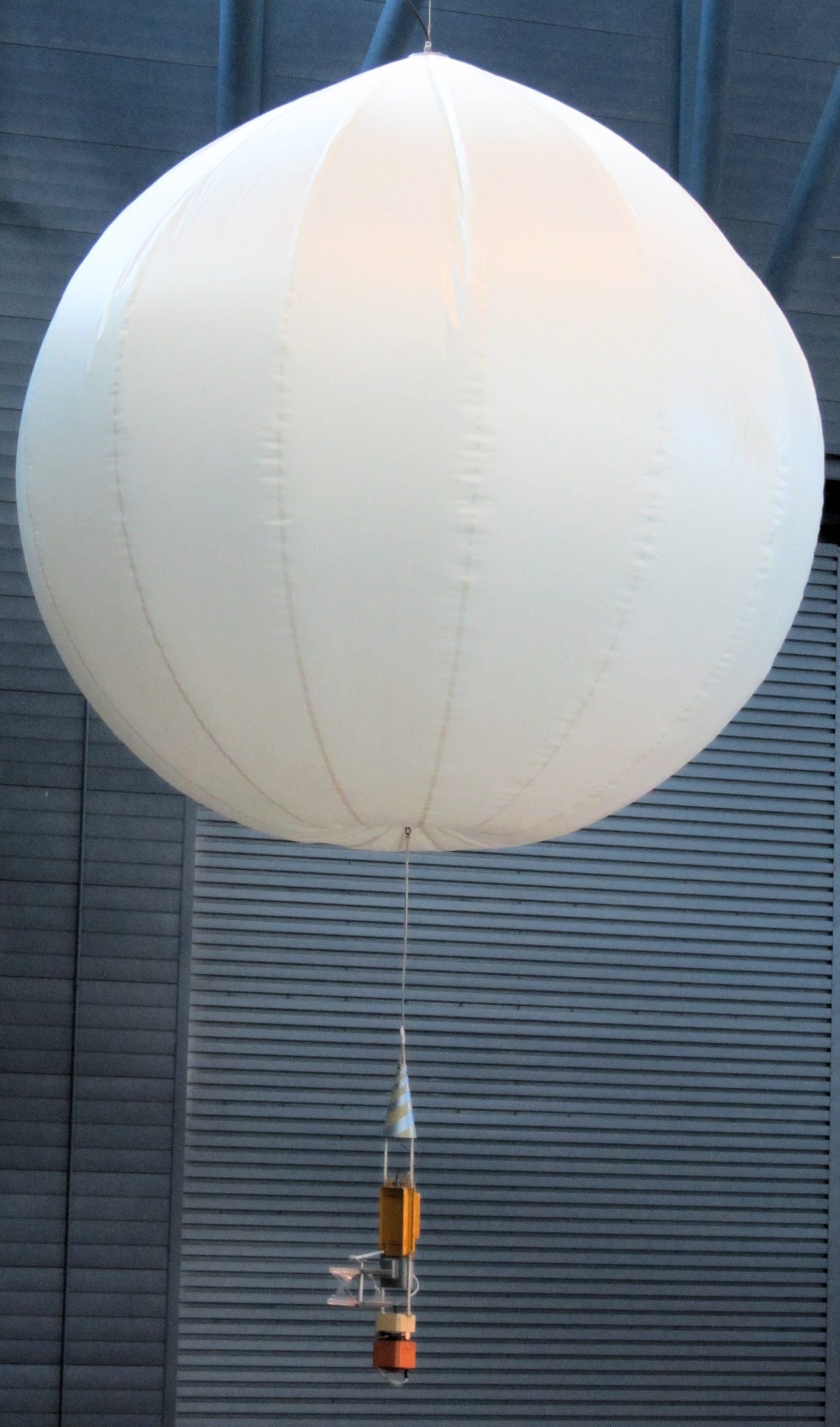Vega Balloon
A key past mission is the Vega balloon.
The two balloon aerobots were designed to float at 54 km (34 mi) from the surface, in the most active layer of the Venusian cloud system. The instrument pack had enough battery power for sixty hours of operation and measured temperature, pressure, wind speed, and aerosol density. The balloon envelopes were surfaced with polytetrafluoroethylene to resist attack by the corrosive atmosphere. Both Vega-1 and Vega-2 balloons operated for more than 46 hrs from injection to the final transmission.
The balloons were spherical superpressure types with a diameter of 3.54 m (11.6 ft) and filled with helium. A gondola assembly weighing 6.9 kg (15 lb) and 1.3 m (4 ft 3 in) long was connected to the balloon envelope by a tether 13 m (43 ft) long. Total mass of the entire assembly was 21 kg (46 lb).

Table of Past Successful Missions
| Mariner 2 (P-38) | 27 August 1962 | NASA United States | Flyby | Successful | Flyby on 14 December 1962 | Atlas-LV3 Agena-B |
| Venera 4 (4V-1 No.310) | 12 June 1967 | Lavochkin Soviet Union | Atmospheric | Successful | Returned atmospheric data during entry on 18 October 1967. Never intended to work on surface[7] | Molniya-M |
| Mariner 5 | 14 June 1967 | NASA United States | Flyby | Successful | Flyby on 19 October 1967, closest approach at 17:34:56 UTC[8] | Atlas SLV-3 Agena-D |
| Venera 5 (4V-1 No.330) | 5 January 1969 | Lavochkin Soviet Union | Atmospheric | Successful | Entered atmosphere on 16 May 1969, operated for 53 minutes | Molniya-M |
| Venera 6 (4V-1 No.331) | 10 January 1969 | Lavochkin Soviet Union | Atmospheric | Successful | Entered atmosphere on 17 May 1969, operated for 51 minutes | Molniya-M |
| Venera 8 (4V-1 No.670) | 27 March 1972 | Lavochkin Soviet Union | Lander | Successful | Landed at 09:32 UTC on 22 July 1972. First fully successful landing on another planet. | Molniya-M |
| Mariner 10 | 3 November 1973 | NASA United States | Flyby | Successful | Flyby on 4 February 1974; closest approach at 17:01 UTC; observed Venus and performed gravity assist to reach Mercury | Atlas SLV-3D Centaur-D1A |
| Venera 9 (4V-1 No.660) | 8 June 1975 | Lavochkin Soviet Union | Orbiter/Lander | Successful | Entered orbit on 20 October 1975; lander landed at 05:13 UTC on 22 October. First images from the surface of another planet. | Proton-K/D |
| Venera 10 (4V-1 No.661) | 14 June 1975 | Lavochkin Soviet Union | Orbiter/Lander | Successful | Entered orbit on 23 October 1975; lander landed at 05:17 UTC on 25 October | Proton-K/D |
| Venera 11 (4V-1 No.360) | 9 September 1978 | Lavochkin Soviet Union | Flyby/Lander | Mostly successful | Flyby on 25 December; Lander landed at 03:24 UTC the same day. Multiple instrument failures on lander | Proton-K/D-1 |
| Venera 12 (4V-1 No.361) | 14 September 1978 | Lavochkin Soviet Union | Flyby/Lander | Mostly successful | Lander landed at 03:20 UTC on 21 December 1978. Both cameras on lander failed | Proton-K/D-1 |
| Pioneer Venus 1 (PV Orbiter) | 20 May 1978 | NASA United States | Orbiter | Successful | Entered orbit on 4 December 1978, decayed on 22 October 1992 | Atlas SLV-3D Centaur-D1AR |
| Pioneer Venus 2 (PV Multiprobe) | 8 August 1978 | NASA United States | Atmospheric | Successful | Entered the atmosphere on 9 December 1978; consisted of five spacecraft, one of which briefly continued transmitting after reaching the surface[9] | Atlas SLV-3D Centaur-D1AR |
| Venera 13 (4V-1M No.760) | 30 October 1981 | Lavochkin Soviet Union | Flyby/Lander | Successful | Lander landed at 03:20 UTC on 1 March 1982. | Proton-K/D-1 |
| Venera 14 (4V-1M No.761) | 4 November 1981 | Lavochkin Soviet Union | Flyby/Lander | Successful | Lander landed on 5 March 1982. | Proton-K/D-1 |
| Venera 15 (4V-2 No.860) | 2 June 1983 | Lavochkin Soviet Union | Orbiter | Successful | Entered orbit 10 October 1983, operated until July 1984 | Proton-K/D-1 |
| Venera 16 (4V-2 No.861) | 7 June 1983 | Lavochkin Soviet Union | Orbiter | Successful | Entered orbit 11 October 1983, operated until July 1984 | Proton-K/D-1 |
| Vega 1 (5VK No.901) | 15 December 1984 | Lavochkin Soviet Union | Flyby/Atmospheric/Lander | Mostly successful | Landed 11 June 1985. Atmospheric probe deployed during entry operated for two days. Main bus continued to explore comet 1P/Halley | Proton-K/D-1 |
| Vega 2 (5VK No.902) | 21 December 1984 | Lavochkin Soviet Union | Flyby/Atmospheric/Lander | Successful | Landed 15 June 1985. Atmospheric probe deployed during entry operated for two days. Main bus continued to explore comet 1P/Halley | Proton-K/D-1 |
| Magellan | 4 May 1989 | NASA United States | Orbiter | Successful | Entered orbit 10 October 1990, deorbited 13 October 1994 | Space Shuttle Atlantis STS-30 / IUS |
| Galileo | 18 October 1989 | NASA United States | Gravity assist at Venus | Successful | Flyby on 10 February 1990 en route to Jupiter; observed Venus during closest pass. | Space Shuttle Atlantis STS-34 / IUS |
| Cassini | 15 October 1997 | NASA United States | Gravity assist | Successful | Flybys on 26 April 1998 and 24 June 1999 en route to Saturn; observed Venus during closest pass. | Titan IV(401)B |
| MESSENGER | 3 August 2004 | NASA United States | Gravity assist | Successful | Flybys on 24 October 2006 and 5 June 2007 en route to Mercury; observed Venus during closest pass. | Delta II 7925H |
| Venus Express | 9 November 2005 | ESA European Union | Orbiter | Successful | Entered orbit 11 April 2006. Full communications lost on 28 November 2014 [10] | Soyuz-FG/Fregat |
| Akatsuki | 20 May 2010 | JAXA Japan | Orbiter | Operational | Flew past Venus on 6 December 2010 after failing to enter orbit. Insertion was successfully reattempted on 7 December 2015. | H-IIA 202 |
| IKAROS | 20 May 2010 | JAXA Japan | Flyby | Successful | Experimental solar sail released from the Akatsuki spacecraft. Flew past Venus on 8 December 2010 but did not make observations. | H-IIA 202 |
| Parker Solar Probe | 12 August 2018 | NASA United States | Gravity assist | Operational | Flybys on 10 October 2018, 26 December 2019, 11 July 2020, 20 February 2021, 16 October 2021, 21 August 2023, and 6 November 2024 to lower perihelion for solar observation. | Delta IV Heavy/Star 48BV |
| BepiColombo | 20 October 2018 | ESA European Union | Gravity assist | Successful | Flybys on 15 October 2020 and 11 August 2021 en route to Mercury; observed Venus during closest pass. | Ariane 5 ECA |
